Elizabeth Adams's Blog, page 98
May 18, 2012
Between the Rocks and a Soft Place
Moss, Lichen, Rocks 1, Thingvellir. Charcoal drawing, 30 x 22." Click image for larger view. or watch a slideshow of the drawing in progress.
This is an excerpt from a journal-manuscript I'm working on:
Why is it so hard to begin again? I started this drawing on March 8, over two months ago. In two days this week, I finished it, but only after weeks of procrastination. Why? It's not that it wasn't clear what needed to be done when I left off, before the apartment réparations began, or that I had forgotten. Each day I walked past the drawing, where it was pinned to the wall, not once but several times. It was en route to the plants which needed water or trimming, en route to the litter box, the bicycle pump, the vacuum cleaner and broom, the big papercutter and wall-mounted mat cutter that I had used several times over the past months to mat and frame relief prints. I kept the drawing carefully on the edge of my peripheral vision as I dragged a string for the cat to chase, or turned the oxalis and angel-wing begonia to face the light, or trimmed the rosemary and laid out the little branches on a paper towel to dry, never stopping to square my shoulders to the wall and confront its insistent presence.
I wanted to, though. That's the thing I don't understand. In general, for me, it's only beginning that's hard, making the start, taking that leap across the paralyzing abyss. I've learned to trust, now, that once I begin, I'll figure out a way through, even if I get lost in the forest for a while, and that I'll learn something along the way. The end result doesn't matter to me so much anymore. It isn't weighted the way it was when I was younger and had less time for art, or when I was always judging, judging...myself, and what other people might think, as if failure was always right around the next bend. And that strikes me as an odd grace, that now, when I'm so much more aware of the fleeting nature of time and how little may remain, it opens up because I'm learning to let go.
So one morning this week I cleaned off the drawing table, putting away the copies of our filed citizenship applications, the Croix Bleue folder full of insurance forms, the GST and QST tax worksheets. The table was dusty on the edges, and I swept it clean with a drafting brush and ran a damp sponge over the surface and polished it off with a paper towel. Then I replaced the large sheets of paper I like to keep underneath my work, to give a slightly softer working surface than the melamine-covered wood, and finally went over to the drawing, unpinned it, and laid it on the table. Beside it I set a box of compressed charcoal, and another of soft willow charcoal, a thick white eraser, a pen-like holder with a thin, round, white eraser core.
And the conversation commenced, as it does with ingredients laid on the kitchen counter; the drawing again became a living thing with which I was about to interact, as I decisively laid it there and addressed it with what - a prayer? A command? -- I don't know what that moment of beginning really is, or what we say to the blank or unfinished page, or what it says to us. There is a that moment, though, in its unwritten language, a breath or two, then decision: I choose a tool, take a piece of charcoal in my hand, and make a series of quick marks, there, and the past disappears.
---
Every drawing or painting ends up involving some sort of obstacle; when they don't, you know you're getting repetitive. In this one, the difficulty was in finding a way -- a shorthand, in effect -- for depicting the soft texture of the sphagnum moss in contrast to the hard surface of the underlying rocks. The rocks were easier, and in the end I even simplified them further and further, rubbing out decades of previously-drawn lichen-growth with the side of my hand.
For the moss I decided to try making an all-over scribbling pattern of little circles, first with a hard, fairly sharp black charcoal stick. What had to come across was the thickness and softness of the rounded sphagnum mat above the smooth rocks. The scribbled black texture alone, even over a background that had been shaded to indicate the pattern of light that defined the curves, wasn't enough. I began again,this time working from dark to light with the small pointed eraser, removing pigment in the same small circular pattern, keeping the lines as loose as I could, and finally the forms took shape: a calligraphy of moss.
May 16, 2012
The Scariest Breakfast Ever
Yes, I know. That doesn't look scary: it looks like a small bowl of bran flakes with sliced bananas.
Which is exactly what it is.
Except that these are the first bananas I've eaten in, let's see, 59 minus 19 = 40 years.
I stopped eating bananas when I was in college, after getting violently sick after consuming one -- intestinal cramps, diarrhea -- and not for the first time; I had suspected for a while that bananas didn't agree with me. But this final incident was much worse - like an allergic reaction. So I just stopped, and since then I've told people I can eat just about anything, except bananas. And oysters.
But lately, I started thinking I wanted to try again. J., who loves them, had just bought a bunch of particularly delicious-looking bananas, and on Sunday, as we made our coffee and fixed bowls of cereal, I said, OK, let me have a taste. I ate one bite, and waited. Hours went by...nothing happened. So the next day I ate three slices. Again, nothing. And yesterday, I ate the breakfast in the picture above, and I'm still here, none the worst for wear, except that (a) I'm delighted to think I can add this wonderful food back into my eating repertoire and (b) I feel like an idiot.
Well, OK, not an idiot exactly, but I'm perplexed. Was this a real thing, at one time in my life - a real allergy - that I've outgrown? Or have I been under a forty-year illusion? Either way, what I thought was reality has a sudden curve in it. How many things in life are like this? How many fears are actually baseless? How much living do we avoid because of those fears, or illusions? Conversely, how much does one's body chemistry change over time? My suspicion is that it changes more than we think, particularly with regard to digestion. I used to be much more lactose-intolerant than I am now, for instance, and my entire digestive system works much much better since I adopted different and healthier eating habits, which took place over a fairly long period of time, most of the entire last decade. Developing a bleeding ulcer ten years ago and learning what was going on in my insides, with the help of an excellent GI specialist at Royal Victoria Hospital, was one precipitating factor. I changed my diet to include considerably more fiber, whole grains, whole foods, less sugar, less fat, less meat, more fruits and vegetables. Living in Montreal had something to do with it too -- we are able to eat a greater variety of food here, it's fresher, and while it's not all organic, there are fewer additives and preservatives allowed by law: in fact, a USDA inspecter at the border once told me if she could, she'd only eat Canadian food products because she knew what the differences were. I tried to learn about, face, and take steps to control the stress in my life. And I stopped using aspirin or any other form of anti-inflammatory medication, which were, in my case, after all the tests came in, the immediate reasons for the bleeding ulcer.
Anyway, to get back to the hero of today's story: I don't know if I'm ever going to be able to look a banana in the eye and not have a moment of thinking of it as potential poison (and you with gutter-minds, just stop that thought in its tracks...) but I do feel like I've been given a gift, not just in terms of a food I'll enjoy eating, but the questions it's prompted me to ponder. What else lurks in the shadows of my life, avoided, feared, abandoned, untried for decades? Isn't it time to find out?
May 14, 2012
Self-portrait with Bicycle
May 13, 2012
Mother
Today, wandering up to the studio on a day that began with rain and turned to sun, I'm thinking of my own mother, who I lost almost exactly six years ago; of the children I never had myself; and the people who've become as dear to me as if they were those children, but are friends besides.
There are dark purple violets blooming in the alleys - my mother's favorite flower. And muguet de bois, lilies of the valley, with which I filled the house on the day we said goodbye to her. In so many ways, she's never left, and what continuing solace and strength I've found in remembering her. She'd be glad of that.
May 10, 2012
Two Haiku
A too-mild winter
even the tender boxwood
lost barely a leaf
---
Shivering tulips
scan the shadowed canopy
for any sign of sun
Free books, and a special offer
Goodreads Book Giveaway

Ancient Lights
by Dick Jones
Giveaway ends May 15, 2012.
See the giveaway details at Goodreads.
Enter to win
May 7, 2012
Annunciations
Natalie d'Arbeloff did a recent take-off on a Fra Angelico "Annunciation," for her accordion book project, and asked if any of us could identify the source. I did a little research to identify the original painting, but then found myself looking at other versions of the same subject by the same artist: Fra Angelico, who lived in Renaissance Italy between 1395 and 1455.
It wasn't unusual for Renaissance artists to revisit a common subject like the angel Gabriel telling Mary she was going to bear a child, especially when they were commissioned to paint complex altarpieces (see the full example in the third image, below) which often showed scenes from the life of Christ.
 What's particularly interesting, though, is how the depictions change. The gestures and attitudes of the figures may, at first glance, look similar but they often show an evolution in the artist's thinking about what was going on in the story, or they may reflect the desires, position, or status of the patron who has commissioned the work.The painting that Natalie used (at left) has a formal composition, with the figures arranged in opposition and framed by the architecture of the courtyard and the formal garden beyond it. However, those are pretty fantastic striped wings on Gabriel! Here Mary is leaning forward to receive the message from the seated angel, who points toward heaven. Though it looks earlier, this is a small painting from a series Fra Angelico did not manage to complete at the end of his life.
What's particularly interesting, though, is how the depictions change. The gestures and attitudes of the figures may, at first glance, look similar but they often show an evolution in the artist's thinking about what was going on in the story, or they may reflect the desires, position, or status of the patron who has commissioned the work.The painting that Natalie used (at left) has a formal composition, with the figures arranged in opposition and framed by the architecture of the courtyard and the formal garden beyond it. However, those are pretty fantastic striped wings on Gabriel! Here Mary is leaning forward to receive the message from the seated angel, who points toward heaven. Though it looks earlier, this is a small painting from a series Fra Angelico did not manage to complete at the end of his life.
In the version below (Convent of San Marco, late 1430s) the figures are under the porch, and the feeling is much more intimate. They've both got haloes; Gabriel's wings are feathery and developed, but he too has his arms crossed and seems almost to be bowing before Mary. The garden at left is developed and realistic.
In the famous "Prado Altarpiece" (1430), painted for the Church of San Domenico in Fiesole and sold to Spain in 1611, the theology of the incarnation has been developed through extensive use of symbolism. The garden becomes the garden of Eden, with Adam and Eve being thrown out in humanity's fall from grace. These two events are tied together, indicating the reversal that Christ's birth was supposed to represent for human beings.
I spent more time studying yet another version, below, from Fra Angelico's Cortona altarpiece (1432-1434). The figures are fluid, realistic, and arrested in their motion; the perspective is complicated; there's a lot of gold being used -- look at those gilded wings and coin-like haloes -- and the decorative details everywhere in the painting are very developed and elaborate. Gabriel even speaks golden words toward Mary, and there is a lot of nuance in her gaze and their gestures.
Ultimately, inspired by Natalie's example, I began thinking about making a relief print based on this painting. I did a sketch, looking at the painting on the computer screen, and then worked on tracing paper with pen and ink, simplifying the poses, exaggerting some features, and adding heavy ink margins to my drawing. Then I cut out the figures, making deliberately rough outlines, and moved them around; then I glued them down and did some more drawing, cutting and glueing.
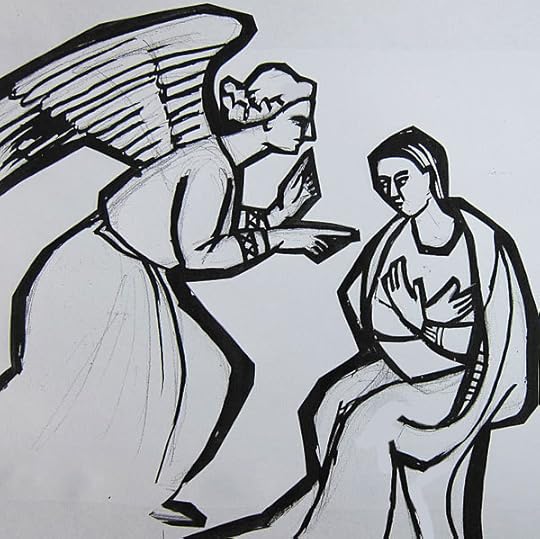
I was interested in what the placement said about their relationship, but also in the more abstract issue of how the shapes fit together and interacted, even before the addition of haloes and any background structures. I decided to zoom into the scene to concentrate attention on the actual encounter. It seemed like I wanted Mary to be definitely seated, and lower than Gabriel, but I don't like her downcast eyes; her crossed hands are submissive enough. In the next iteration I'll change the gaze so she's looking up at him, and change his eye so that it looks down. I do like what's happening now in the negative shape between the two of them, and want to go further with the positive/negative shapes and overall abstraction. This is all very preliminary, but it seems like there are still a lot of ways to go with this, 600 years later, so stay tuned for further developments!
May 5, 2012
Wild Fire
My friend G. is a research scientist living on Long Island. He also loves to hike and kayak and explore natural places, and is keenly interested in the ecology of that part of the world. The recent wild fires on Long Island were nearby, and when he sent me these photographs as part of a letter, I asked if it would be OK to share them with my readers. G. expanded on the text a little, and this is the result. In his first paragraph he speculates, tongue-in-cheek, about the origin ofthe fire; in the past week, however, he wrote to tell me that ongoing investigations are increasingly suggesting arson.
On a clear windy day, a little over a week ago, a brush fire started in the tinder-dry pine-oak woods of Eastern Long Island, not far from the Relativistic Heavy Ion Collider, a nuclear physics machine designed to create and observe the hottest matter ever made on Earth, thousands of times hotter than the center of the sun. The source of the fire remains under investigation. More likely a careless cigarette butt than an escaped quark-gluon plasma, in my opinion.
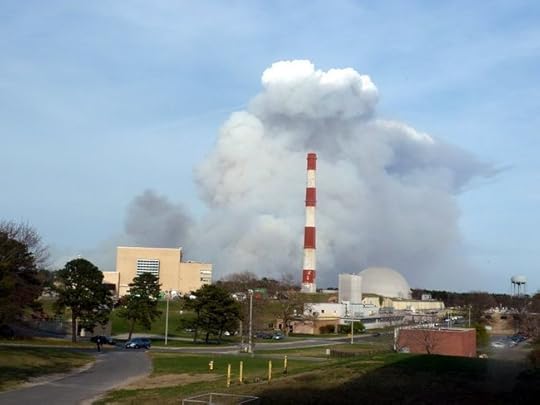
By late afternoon, smoke was visible for miles in all directions. Volunteer fire fighters from more than a hundred local departments across Long Island were working to keep the fire contained and away from the clusters of homes as the wind swept the front of the fire line eastward across sparsely populated woodlands. First thoughts, of course, turn to friends who live downwind, with their organic garden in the woods and small flock of pastured, named chickens who supply us with eggs. Then to their unknown neighbors, and to the countless volunteer fire fighters, who train and equip for just such occasions, who enjoy a special camaraderie, the intermittent gratitude of their neighbors, a rare opportunity for heroism amid danger, plus a chance to dig in the sand with their expensive toys.
When it is over in the morning, I read that over 1100 woodland acres have been scorched, several homes and businesses destroyed, but mostly astonished relief at how much worse it could have been, with only a few minor injuries among the fire fighters. After catching up on the "where were you when..." stories with friends and acquaintances, it is time to think about mourning for the woods that feel like my own, through which I often walk to work, solitary miles of sandy paths, through pitch pine and scarlet oak, blueberry and cat brier, more likely to encounter white-tailed deer and wild turkey than a fellow walker.
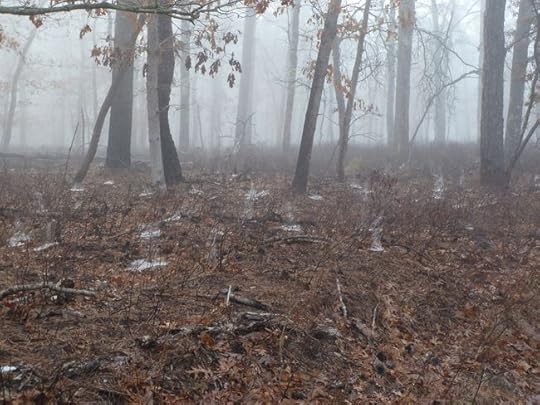
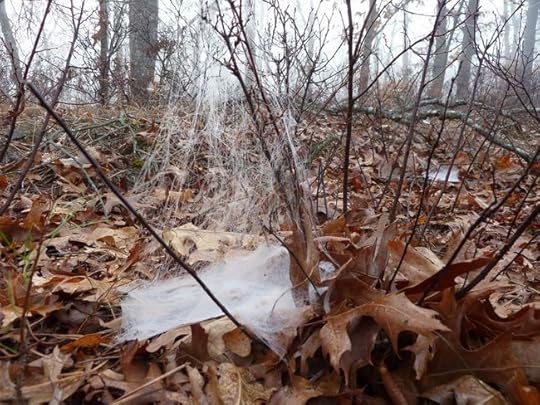
Here, a foggy morning walk through these woods only a few weeks before the fire. The leaf-litter is decorated with the foiled camouflage of ground webs, deadly-invisible to unsuspecting insects in dry weather, but now revealed to all in a cloudy dew. Even the architect is too embarrassed to be seen next to her luminous creation, far too visible to be functional.
--
The disaster tourist's urge to gawk is restrained by closed roads, continuing fire danger and police investigations for a day or two, but eventually I am drawn to the smoky devastation, to see for myself.
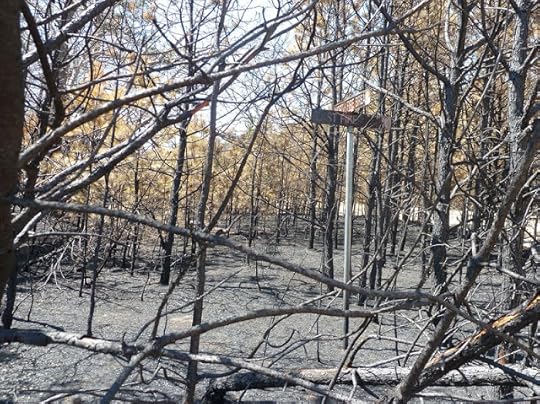
Failed Firebreak
Unnamed sand roads cross in the woods.
Hidden by overgrown pitch pine saplings, stands a street sign
incongruous, once red, now charred and blistered,
East Firebreak and North Firebreak
dividing four quadrants of scorched earth.
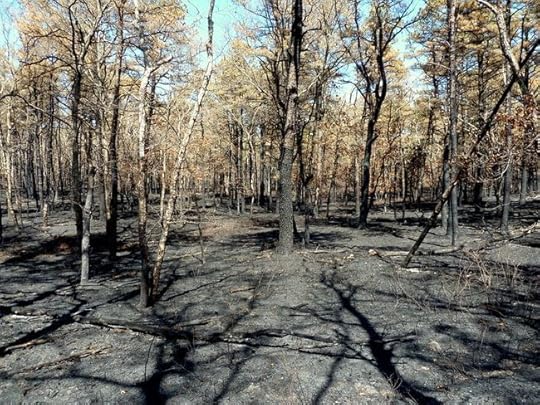
What was once pine needles, leaf litter, early spring-dormant underbrush, and a generous tangle of new windfall from last autumn's tropical storm Irene, is now monochrome black and grey, stretching to a more distant horizon, a rolling carpet of lustrous charcoal in the shapes of needles, twigs, and logs. The standing trees are in shock. Many will survive, but for now, the needles change from unhealthy yellow-green to brown, almost as I watch. I tell myself, these woods are made for fire. The pines and the oaks take one more step in their battle for sunlight. And a cleansing burn of the understory is something that in retrospect, we can wish had been done more proactively throughout the pine barrens, to reduce the danger of the truly rampaging wild fire that might one day follow the fuel and wind through an area 10 times or 100 times larger, making us wonder, whose land is this, anyway?
Our western neighbors, toward "the city", have already cleared and paved their habitat, leaving a few parks and many lawns, but little wild land or wild fire danger, just as thoroughly as we have exterminated wolves and bears. We need not pave and exterminate, indeed we depend on these wild acres not only for their wildness, but also to recharge our wells with rainwater better than what we drain through our cesspools. But those of us who choose to intrude on the woods must expect to be part of nature's cycles, like tenants on the fault line, or in the flood plain.
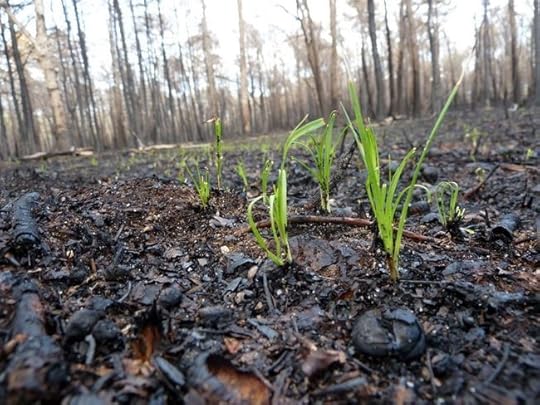
A week later, and we've finally had a soaking rain. Roots beneath the char push out new growth and the race is on again. The air is still heavy with damp smoke odors, but alive with territorial bird calls, pronouncing their intent to start over.
May 4, 2012
Spring, yesterday
Old man bending his face
toward the blue hydrangea
holding one leaf
like a lover's hand
May 1, 2012
Brand New: Ancient Lights
Better than a May-basket full of daffodils: today I'm delighted to announce the publication of Dick Jones' Ancient Lights, the latest title from my micropress, Phoenicia Publishing. His first full-length collection of poems is being released today in a gorgeous hardcover edition, a standard paperback, and as an e-book.
Dick is an old friend at The Cassandra Pages -- we met online a number of years ago through our blogs (his is Dick Jones Patteran Pages), and in person for the first time this past fall when J. and I were in London. We quaffed a few pints together at a neighborhood pub, along with several other blogger friends, talking of warm beer, mushy peas, and,of course, books. Dick is a wonderful person, gifted musician, and a brilliant poet whose work has spoken to me and touched me deeply over all the years I've known and read him. It seemed like a great literary omission that his work hadn't yet been gathered into a printed collection. I'm proud to have been his editor, designer and publisher for Ancient Lights, and hope it will mean that his poetry is available to a wider audience, and has a greater assurance of posterity.
In his poems, Dick writes of life and relationships, deeply felt but never sentimental, in strongly-crafted English that proceeds from the tradition of Eliot, Thomas, and Heaney, but is very much his own: restrained but filled with truth, sharp observation, memory, and emotion; never showy or deliberately clever. He is a poet who gets close to the truth as I feel it myself, and so the words feel personal, and timeless, whether he is writing of his boyhood just after WWII, his loves, his travels, his children, the deaths of his parents, or his own mortality.
I hope you'll agree, and consider buying one of these editions for yourself or a friend -- you'll be supporting independent publishing and art as well, since we return a large portion of the profits to the authors. Please take a look at the book description over at the Phoenicia site... if you aren't familiar with Dick's work, you can read a selection and hear the poems read by the author at qarrtsiluni, where Dave Bonta and I nominated Dick for a Pushcart Prize in 2010, for this poem:
SEA OF STARS
They will require,
should I return,
that I give name
to all the things I saw.
Even as I feed back
voltage, trickle chemistry
past their electrodes;
even as I share
my heartbeat with their monitors,
my blood with their microscopes,
they will question
in quiet voices,
seeking out new nouns
with which to corner
the ineffable, new verbs
to charge the immaterial.
As now their aerial voices —
filtered through ionosphere,
the shingle-clouds of asteroids,
across these tideless oceans —
whisper insubstantial, needle-thin,
scratching their need to know
the unknowable onto the mighty
silence. I trail interrogation
like a shower of sparks.
But from this eminence
I no longer heed
their eyes that scrutinize,
lidless, unswerving. This dark
accomodates a billion eyes, speculating
my parabola by day, by night, probing
for my tiny skidding light.
Implacable, incurious, I navigate
the brilliant wastes — long black
sargassos drifting, planet wrack
and flotsam, dereliction.
And beyond, always beyond,
the bright flying splinters of the stars.
--Dick Jones

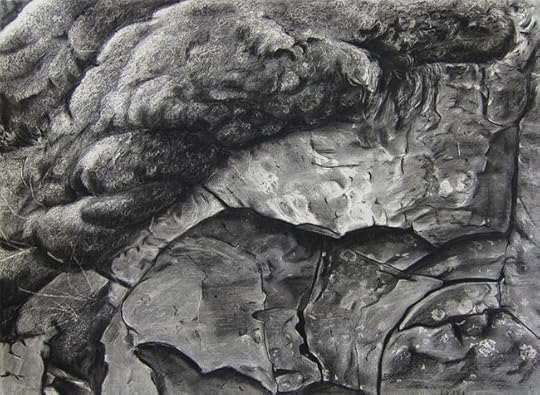



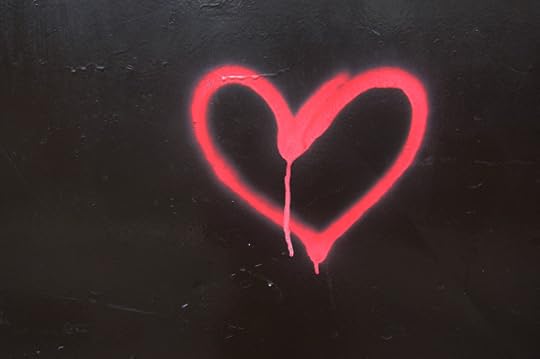
![Beato-Angelico_Annunciazione-corridoio-nord-San-Marco-Firenze[1]](https://i.gr-assets.com/images/S/compressed.photo.goodreads.com/hostedimages/1417131557i/12235601._SX540_.jpg)





